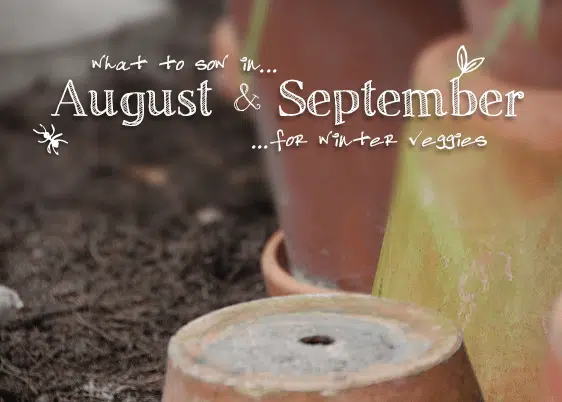August is usually more about harvesting than sowing. Pick up any gardening magazine or book and you will likely be faced with lists of plants ready to pluck out of the ground. “Winter vegetables” don’t always get a big look in.
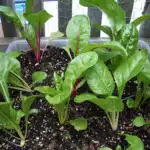
Yet there are heaps of veggies that you can start off now with a view to harvesting in either late autumn/early winter or (for longer-growing veggies) next year in spring. Temperatures start to drop pretty quickly through September and October, but there’s still enough light and warmth to get another harvest in.
By picking fast-growing crops you’ll ensure that you have fresh food throughout November, December and January. Alternatively, you can sow overwintering crops like broad beans and cabbages for a harvest in spring.
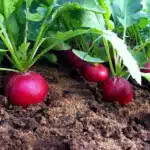
There tends to be a lot of confusion around autumn and winter vegetables, and terms like “overwintering” can be a little daunting to novice container growers. The reality, though, is rather simple. In this article we’re going to demystify some of the main terms and have a look at some great container crops to sow in August and September.
Depending on where you are in the Northern Hemisphere you may need to adjust your sowing times – if, as I was last year, you’re far north, then it’s better to sow earlier. If you’re in a city, such as London with its warmer microclimate, then you can keep sowing through September.
Autumn Crops and “Overwintering”
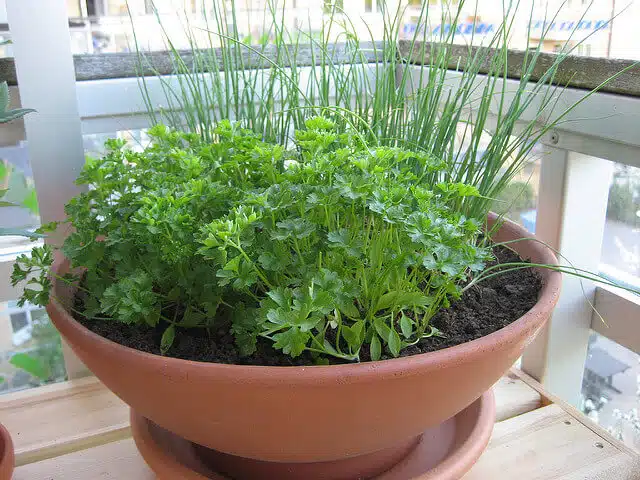
There are two categories of “autumn and winter vegetables” that you can sow now…
- Fast-growing crops for an autumn harvest – These veggies are usually planted in August or early September with a view to harvesting before growth slows to a stop completely towards the end of November, when low light and temperature levels cause plant dormancy. If you’re picking leaves (as opposed to harvesting fully) through autumn and winter, growth will often resume in spring, so you’ll have an en early harvest to look forward to.
- Vegetables for “overwintering” and harvesting in spring – These are usually planted in autumn, in August or September, for harvesting in spring next year rather than winter. The idea is to let plants, particularly longer-growing varieties, get established before the cold weather (and dormancy) sets in. When the weather heats up around March time (see the month-by-month table of London temperatures below) they resume growth. One thing that often catches newer gardeners out is the task of deciding which plants are suitable for overwintering. Some veggies simply aren’t suited to dormancy in colder temperatures. Cold weather will kill beetroot and carrots, for example, which is why they’re not commonly overwintered.
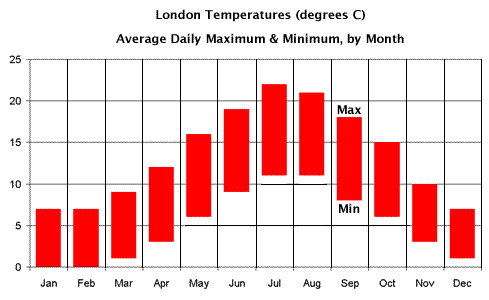
(Source)
Best Winter Vegetables for the Container Garden in August and September
For best results, bear the following pointers in mind…
-
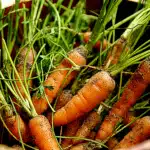
Carrots are excellent for swing now. Opt for baby and dwarf vegetables – There are two types of “baby” vegetables – varieties that are small when fully grown and normal plants that have been harvested before full maturity. Both are viable options for late-season gardening and are very tasty.
- Leafy veggies work well – Leaf vegetables, because all of their edible growth is above ground, tend to be fast-growing.
-
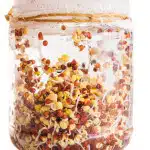
Sprouts can be grown all year. Microgreens and sprouts are a good backup – If you’re not overly keen or don’t have the time to tend to containers throughout the colder months, then microgreens and sprouts can add some fresh, homegrown greenery to your winter meals. Just a few trays and jars on your kitchen windowsill will keep you well-supplied. Check out our two-minute guide to growing sprouts here.
Protecting Pots and Plants
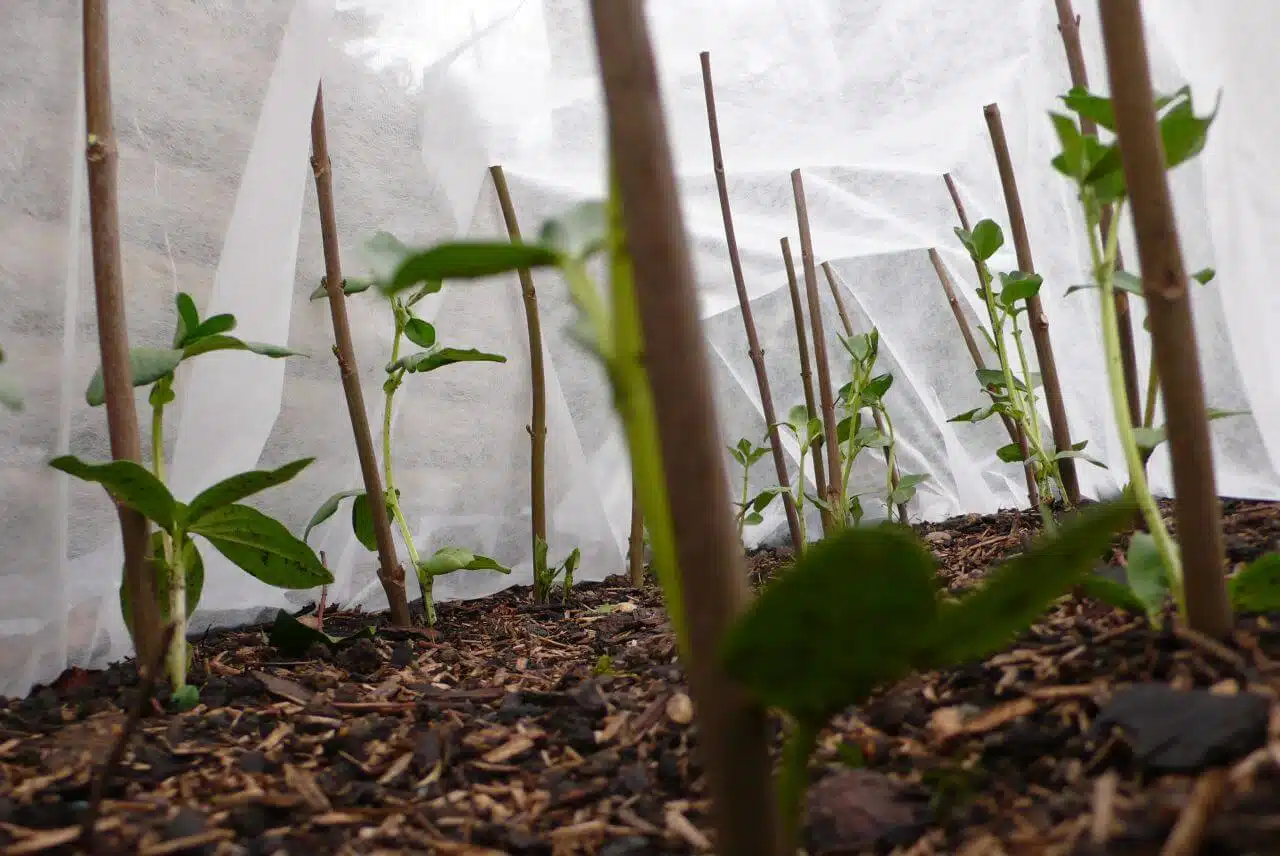
As a general principle, the warmer the better. You can always do a little bit extra in terms of alleviating the negative consequences of the cold. As a container grower, consider some of the following pre-emptive tips…
- Wrap pots in bubble wrap. This will mean that plants’ roots aren’t standing in frozen water for an extended period of time.
- Lift pots off the ground to allow excess water to drain away. Again, this will mitigate the effects of cold and frozen water.
- Placing straw on the surface of pots can protect top growth. Steal it from the rabbit!
- Cloches and fleece are always a good option. I like cake cloches with a few holes drilled in for ventilation. Horticultural fleece (as in the image above) can also be used.
- Provide shelter from the wind. Persistent wind-chill can have a negative effect on plants that are already struggling with the cold.
- Stay on top of watering in August. Remember that it’s still a very hot month
Vegetables for a Late Autumn/Winter Harvest
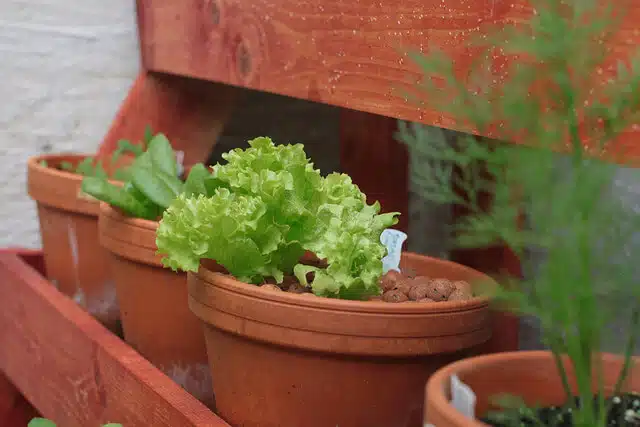
Remember that root vegetables can be kept in the ground and picked as needed over winter. Cloches can also come in handy here, particularly for extending the growing season of salad leaves, which will often resume growth in spring as long as you don’t overpick.
Lettuces and salad leaves
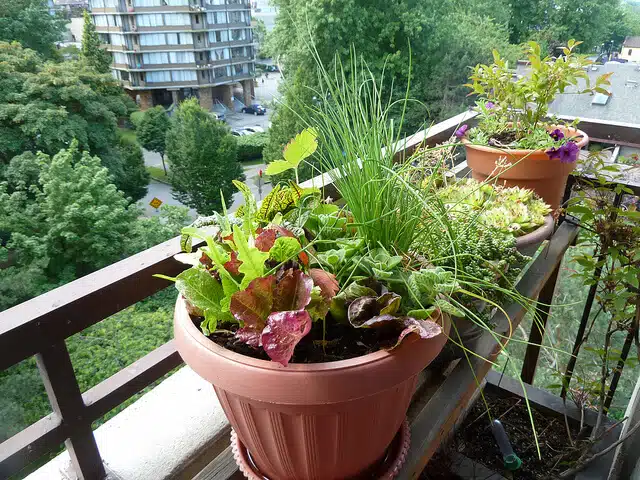
I love lettuces and salad leaves and they both have a big presence in my container garden through autumn and winter. They’re such versatile crops and there are enough varieties to ensure a near continuous yearly supply of leaves, as long as sowings are well-organized. Fast-growing loose-leaf and butterhead lettuces can be planted now for harvesting throughout late autumn and winter.
- Winter purslane/claytonia – Sow winter purslane in August or early September (July is also a good time), making sure that the seedlings are well-watered. You can harvest all through winter and spring until white flowers begin to show. Time to harvest: 8 weeks.
- Land cress/American cress – Land cress is rich in calcium and iron and has a short growing time. Along with being quite a vigorous plant, which means you can make cuttings often, it’s also a perennial, so will stand in the ground indefinitely, thought leaves can become a bit astringent after flowering. Time to harvest: 4 – 6 weeks.
- (Wild) rocket – Rocket is an absolutely fantastic choice for winter growing. One strategy is to let a few of your summer plants go to seed and then replant with the saved seeds around August. A cut-and-come again approach is better suited to summer-grown rocket, so my advice is to harvest your winter plants in one go. Time to harvest: 4 – 6 weeks.
- Lettuces – I fill my pots with lettuces through autumn and winter. They’re absolutely ideal for sowing now and, with the right care, can provide you with harvests all through winter. Tom Thumb is a particularly fast-maturing veggie and, because of its diminutive size, you can stuff quite a few into your pots. Lollo Rosso and Salad Bowl are two other easy options. Time to harvest: 8 – 12 weeks.
- Mustard greens – The term “Chinese” mustard green encompasses a wide variety of leafy edible plants that are popular in Asia. Many mustard varieties really look the part so are a good choice if you want a few edible ornamentals in your container garden. Mustard “Red Giant” is a good choice that will cope well with low temperatures (even growing under snow). Time to harvest: 6- 8 weeks.
- Spinach – You can sow spinach in August and September with a view to harvesting baby leaves or let them overwinter (provide protection) for cropping in spring. Time to harvest: 4 – 6 weeks.
Turnips, Carrots and Beetroot (Root Vegetables)
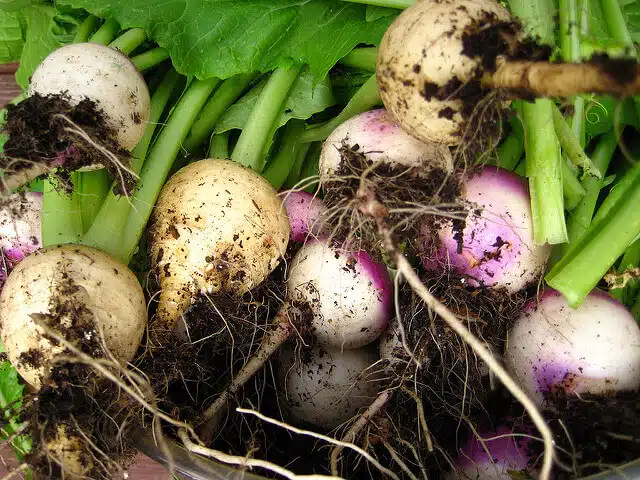
August and September are the perfect months for starting another batch of root vegetables. Unless your going for genuine baby varieties, they probably won’t reach full maturity by the time they need to be harvested.
Root vegetables are best started in modules early in August when containers are still in use. That way you can pop the strongest plants into the soil towards the end of the month
- Turnips: I find that turnips sown in August or September are best picked when about the size of a golf ball (or a little under) and eaten raw. Fast-growing white turnip varieties are preferable, as opposed to larger “swede” turnips that are more bulbous and develop a purple coat. Two months is the usual time from sowing to harvest. Alongside being perfect ingredients for warming winter stews, turnips aren’t overly-fussy about their growing conditions. Because of this, turnip growing is a great way of getting a second (or even a third) harvest from your nutrient-depleted potting mix. You will want to add a little balanced feed (I favour pellets or granules that will release over several months) that contains micronutrients along with the typical NPK balance, but apart from that they should be relatively hassle-free. And don’t forget about the leaves! Charles Dowding recommends the varieties Milan Purple Top and Golden Ball.
- Beetroot: Autumn beets should be harvested whilst small. You want to sow as early in August as possible as they need at least 8 to 12 weeks for the roots to develop sufficiently. You can always, of course, just grow for the leaves. Boltardy is always a good choice for a fast-growing, relatively trouble-free variety.
- Carrots: August is a great month for sowing fast-maturing varieties of carrots. Chantenay carrots are a good choice, as are Adelaide and Parisienne.
Radishes
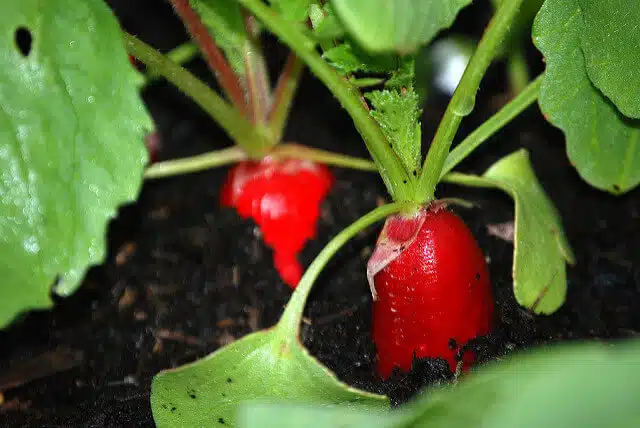
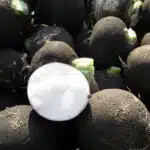
Radishes are another mainstay of my container garden around this time of year. They’re incredibly fast-growing (with some varieties taking no longer than 4 weeks) and all parts are edible. Try opting for a few different varieties, filtering out the ones that you like. Taste and texture can be somewhat different.
There are also winter radishes, which tend to have a black skin, that take a little longer to grow but tolerate the declining temperatures very well. These will be ready for harvest around October/November.
Vegetables for Overwintering for a Spring Harvest
As has already been mentioned, these vegetables are very hardy and will go dormant throughout the winter months (December, January and February), resuming growth again in March for a late Spring harvest (usually around May time).
Onions and shallots
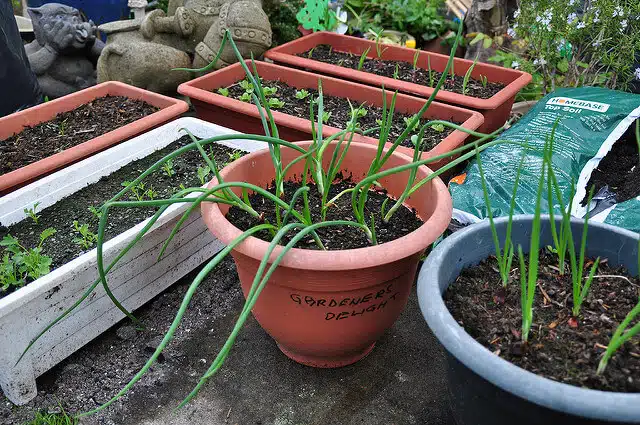
Onion and shallot sets – small bulbs that are used instead of seeds – can be planted in August and September with a view to summer harvesting. Onions have a long growing season that will usually extend over the whole of spring. If you can get some sowings in by early August, you can also grow from seed.
It’s important that you pick the right varieties for overwintering as not all are immune to cold exposure. For shallot sets wait a little longer before planting (late September or October).
Make sure that your containers don’t get waterlogged over winter if you’re going to experience heavy rain. The result will be pot-fulls of little rotting onions!
RHS (Royal Horticultural Society) recommends the varieties ‘Jemor’, ‘Eschalote Grise’ and ‘Yellow Moon’ for autumn planting. You can also sow spring onion seeds for an early spring harvest. They’re cold-hardy and will resume growth quickly.
Cabbages
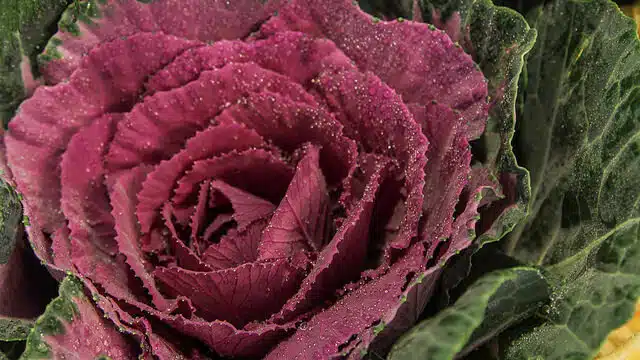
Spring cabbages are best sown around mid-August. Any later than this, start them inside with a view to popping the young plants into empty pots after your summer harvest. The idea is to give them enough time to establish before winter without letting them “heart up” (develop the tight “heart” of leaves) before it gets too cold.
Slugs, though they’re less active in winter, can be an issue, so providing a bit of netting is always worthwhile. Netting will also protect against pigeons. One good cabbage tip for container growers is to cram a few more than is ideal into the pots. That way, when spring rolls around you can eat the weaker looking plants (or discard those ravaged by slugs) and leave the stronger ones to resume growing.
Overwintering Lettuces and Salad Leaves
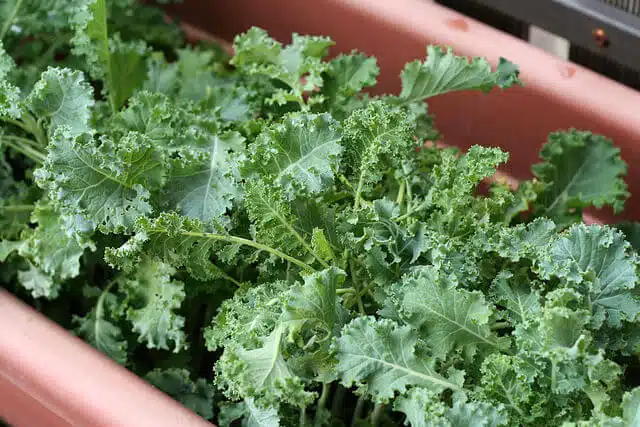
- Lettuces – There are certain varieties of extremely cold-hardy lettuces that you can grow through autumn and winter with a view to harvesting in spring. Unlike the lettuces mentioned above, these are bigger plants that take a longer time to grow. They tend to be butterheads bred to be resistant to the cold. Arctic King and Winter Density are good choices.
- Kale – You can harvest kale earlier but the better option, particularly with bigger varieties like Cavelo Nero, is to leave your plants alone through winter and harvest after they’ve put on some more growth through spring. If they’re large enough during winter, parsimoniously cut off a few leaves (no more than 30%) and leave the rest.
- Swiss chard – Swiss chard leaves will need a little extra protection as they’re not as frost-hardy as other overwintering veggies. Cloches are ideal.
Broad Beans
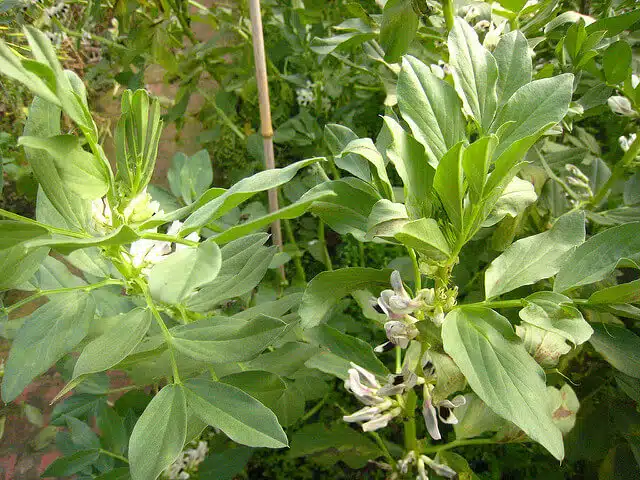
Broad beans are one of the most common “winter vegetables” and can be sown right through until October. With a view to harvesting in spring, it’s always a good idea to stake your broad beans to bamboo canes. It’s important not to allow for too much growth, as frost can damage the stems in winter.
Don’t worry if plants are looking a bit frail or damaged after the winter weather as they will more often than not generate new stems from their bases. Charles Dowding recommends Aquadulce Claudia, which is a widely available, well-known variety.
Garlic
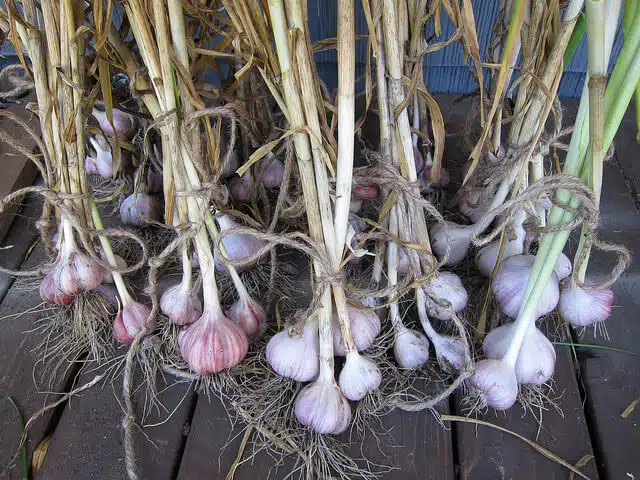
Garlic is ideal for overwintering and incredible easy to grow. Cloves need a period of 6 to 8 weeks of cold (below 10°C) before they can start to establist (if sowing in spring, gardeners tend to leave them in the fridge for a few weeks). Bear in mind, however, that the new bulbs won’t be ready until next summer.
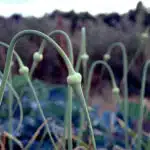
Garlic is great for growing in containers. You can cram quite a few into a single pot and the tastier varieties, particularly the hardnecks (described below), are very difficult to get in supermarkets.
In terms of varieties there are two separate categories of garlic: softneck and hardneck. The softneck varieties are what you typically find in supermarkets, with big bulbs and a milder flavour. Hardneck varieties, so called because they produce a hard central stem called a scape, tend to be smaller but much more scrumptious.
More Resources
- Charles Dowding’s book [easyazon_link identifier=”1900322889″ locale=”US” tag=”urbanturnip-20″]How to Grow Winter Vegetables[/easyazon_link] is invaluable. It’s available on Kindle too!
- I never tire of recommending [easyazon_link identifier=”0903505754″ locale=”US” tag=”urbanturnip-20″]The Vegetable Expert[/easyazon_link] by D.G. Hessayon, which is a fantastic guide for all parts of the growing year.
Send in your pics and don’t forget the leaves
So there you have it! Our little guide to autumn and winter container sowing and growing. If you’re putting seeds into the ground now then please send us your pictures over the coming months so that we can show them on the site. Oh, and don’t forget to eat the edible leaves of your root vegetables either. They’re perfect for those warming winter soups!
References
Aged Terracotta by MJ Ecker, Rainbow Chard by Lori Hutchinson, Radish Time by nicdalic, Persilja och gräslök by Kalle Schärlund, Baby Organic Carrots by Stephen Depolo, Happy Beans by Smoobs, Bottom Floor by Magnus Franklin. Balcony Lettuce by Wendy Cutler, Turnips by McAvoy, Radish by GPI, Black Radish by Schimei Barger,Wobbly Onions by Benjamin Nowlan, Spring Purple III by Fr. Lawrence Lew O.P.,Dwarf Blue Curled Scotch Kale by Rowena, Broad Beans, Full Harvest by sparkle-moon, Scapes by PughPugh.
